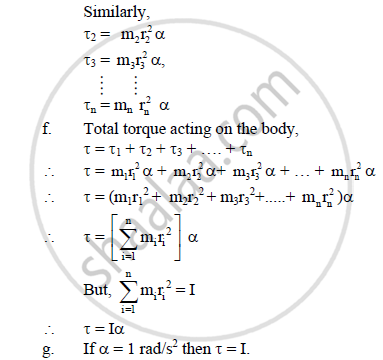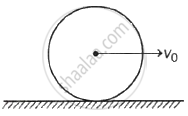Advertisements
Advertisements
प्रश्न
Obtain an expression for torque acting on a body rotating with uniform angular acceleration.
उत्तर
Expression for torque acting on a rotating body

a) Suppose a rigid body consists of n particles of masses m1, m2, m3, ......, mn which are situated at distances r1, r2, r3, …, rn respectively, from the axis of rotation as shown in figure
b) Each particle revolves with angular acceleration α
c) Let F1, F2, F3, …., Fn be the tangential force acting on particles of masses, m1, m2, m3, …, mn respectively.
d) Linear acceleration of particles of masses m1, m2,…, mn are given by, a1 = r1 α, a2 = r2α, a3 = r3α= rnα
e) Magnitude of force acting on particle of mass m1 is given by F1 = m1a1 = m1r1α [ a = rα]
Magnitude of torque on particle of mass m1 is given by,
t1 = F1 r1 sin Θ [∵ Radius vector is ⊥ar to tangential force]


Thus, when a torque rotates the body with uniform angular acceleration of 1 rad/s2 then M.I of the body about a given axis of rotation becomes equal to torque acting on it.
APPEARS IN
संबंधित प्रश्न
Obtain an expression for the torque acting on a rotating body with constant angular acceleration. Hence state the dimensions and SI unit of torque.
Define moment of inertia. State its SI unit and dimensions.
A charged particle (charge = q: mass = m) is rotating in a circle of radius 'R' with uniform speed 'v'. The ratio of its magnetic moment (M) to the angular momentum (L) is ______
A thin metal wire of length 'L' and uniform linear mass density 'ρ' is bent into a circular coil with 'O' as centre. The moment of inertia of a coil about the axis XX' is ______.

The angular momentum of electron in hydrogen atom is proportional to ____________.
If the kinetic energy of rotation of a body is doubled, then its angular momentum ____________.
The ratio of the dimensions of Planck's constant to that of moment of inertia is the dimensions of ______.
A particle of mass m is rotating in a plane in a circular path of radius r. Its angular momentum is L. The centripetal force acting on the particle is ______.
If the angular momentum of an electron is `vec"J"` then the magnitude of the magnetic moment will be ____________.
A homogeneous disc of mass 2 kg and radius 15 cm is rotating about its axis (which is fixed) with an angular velocity of 4 radian/s. The linear momentum of the disc is ____________.
Let I1 and I2 be the moments of inertia of two bodies of identical geometrical shape. If the first body is made of aluminium and the second of iron, then ____________.
An electron has a mass of 9.1 x 10-31 kg. It revolves round the nucleus in a circular orbit of radius 0.529 x 10-10 metre at a speed of 2.2 x 106 m/s. The magnitude of its linear momentum in this motion is ____________.
The direction of angular momentum of particle is ____________.
An electron of mass 'm' revolving around the nucleus in a circular orbit of radius 'r' has angular momentum 'L'. The magnetic field produced by the electron at the centre of the orbit is e = electric charge, µ0 = permeability of free space ____________.
If E, M and P are the kinetic energy, mass and linear momentum of a particle respectively, which of the following relations represents the angular momentum L of the particle when the particle rotates in a circle of radius R?
Three-point masses each of mass 'M' are placed at the corners of an equilateral triangle of side 'a'. The moment of inertia of this system about an axis passing through one side of a triangle is ______.
An electron in an atom is revolving round the nucleus in a circular orbit of radius 5.3 × 10-11 m with a speed of 3 × 106 m/s. Find the angular momentum of electron.
A disc of moment of inertia 'I1' is rotating in horizontal plane about an axis passing through a centre and perpendicular to its plane with constant angular speed 'ω1'. Another disc of moment of inertia 'I2' having zero angular speed is placed co-axially on a rotating disc. Now, both the discs are rotating with constant angular speed 'ω2'. The energy lost by the initial rotating disc is ______.
A particle of mass m = 5 unit is moving with a uniform speed v = 3`sqrt2` unit in the XY-plane along the line y = x + 4. The magnitude of the angular momentum about origin is ______.
The difference in the angular momentum of an electron in two successive orbits of a hydrogen atom is ______.
A sphere rolls without slipping on a rough horizontal surface with centre of mass speed v0. If mass of the sphere is M and its radius is R, then what is the angular momentum of the sphere about the point of contact?

Define moment of inertia.
Define angular momentum.
